

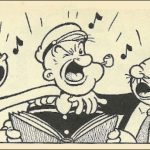
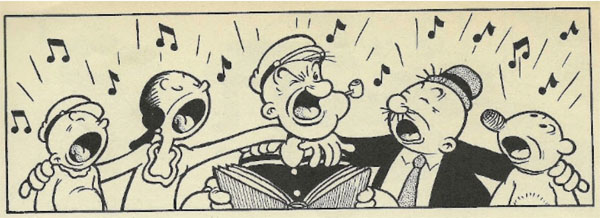 By the mid-1930s, Max Fleischer’s NY Studio reached its highest point with its Popeye cartoons. With so many classics before and after, historians and fans agree that 1936 had many of the best, thanks to many of the pivotal elements adding up. Popeye became a stronger character than ever thanks to Jack Mercer, selected as Popeye’s longtime voice; Gus Wickie becoming the full time Bluto until the move to Miami; Seymour Kneitel, Willard Bowsky, and Dave Tendlar settling in with their unique styles of direction; plus the first two-reel color special, Popeye the Sailor Meets Sindbad the Sailor came to new highs on all levels.
By the mid-1930s, Max Fleischer’s NY Studio reached its highest point with its Popeye cartoons. With so many classics before and after, historians and fans agree that 1936 had many of the best, thanks to many of the pivotal elements adding up. Popeye became a stronger character than ever thanks to Jack Mercer, selected as Popeye’s longtime voice; Gus Wickie becoming the full time Bluto until the move to Miami; Seymour Kneitel, Willard Bowsky, and Dave Tendlar settling in with their unique styles of direction; plus the first two-reel color special, Popeye the Sailor Meets Sindbad the Sailor came to new highs on all levels.
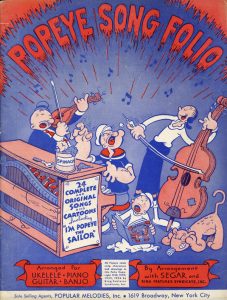 The Popeyes released in 1936 also had the highest number of original (and memorable) songs sung throughout the cartoons, with ten of the thirteen entries featuring a new tune. Everyone already knows Popeye’s theme song, written by Sammy Lerner, opening each cartoon and is often sung in some variant right after the titles. But by now, the Popeye cartoons began regularly implementing original songs, usually with lyrics by Bob Rothberg and music by Sammy Timberg, beginning with 1934’s We Aim To Please.
The Popeyes released in 1936 also had the highest number of original (and memorable) songs sung throughout the cartoons, with ten of the thirteen entries featuring a new tune. Everyone already knows Popeye’s theme song, written by Sammy Lerner, opening each cartoon and is often sung in some variant right after the titles. But by now, the Popeye cartoons began regularly implementing original songs, usually with lyrics by Bob Rothberg and music by Sammy Timberg, beginning with 1934’s We Aim To Please.
These songs usually played in the opening scenes, helping to establish the mood or story of the cartoon, often doing both in the process. One of these songs, Brotherly Love, became a frequent music cue for several more years of the Fleischer Popeyes. Others became memorable pieces of ear candy worthy of Tin Pan Alley, so why not exploit the songs while Popeye sold more tickets than Mickey? So, in 1936, the Popeye Song Folio (pictured at right) was published through Popular Melodies Inc (located at the Famous Brill Building), containing ten of Popeye’s hit movie tunes.
This was, however, not the first piece of sheet music commissioned on the one-eyed Sailor. In 1931, at the character’s initial burst of popularity, Irving Berlin wrote and published a song about Popeye that was covered by Billy Murray (giving the Sailor a tone close to what it would become in cartoons), who, beyond being one of America’s most endearing recording artists of the period, was doing voicework for the Fleischer Studios, even occasionally voicing Bimbo the Dog (ex. Silly Scandals), after he lost his Victor contract in 1929. Later, when Popeye’s iconic theme by Sammy Lerner became a hit and more than anything, contributed to his association with spinach with its lyrics, it too was published as sheet music in 1934. After all, why wouldn’t Popeye eat spinach when the song that opens each cartoon mentions this as the origin of his strength?
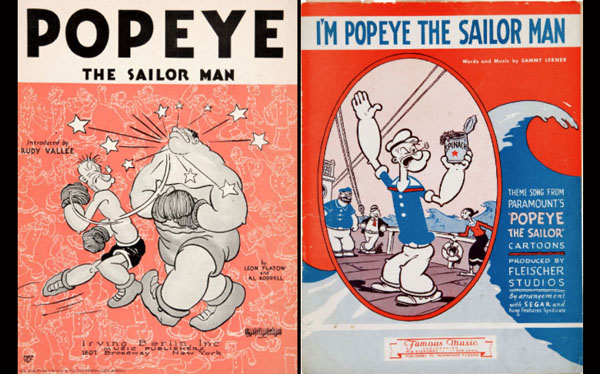
The Popeye Song Folio differed from the two previous publishings in that it offered a variety of new original compositions and attractive interior artwork by the Fleischer artists rather than Segar, which makes one of the few pieces tied directly to the cartoons rather than the comic strip.
I cannot make positive ID’s on the artists, but invite people who may be able to give professional insight in the comments below. I asked Bob Jaques for an educated guess, which he provides below:
“The drawings printed near the bottoms of the pages (except for page 31) are promotional drawings that were done for the Paramount Studio and printed in the Paramount Yearbooks and trade publications – and most likely drawn by Willard Bowsky.”
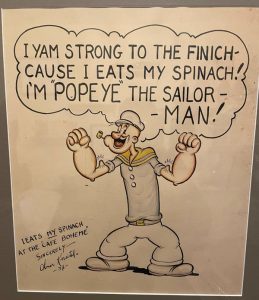
“Many of the drawings on the tops of the pages look like they were done by Abner Kneitel, but some look like they may have been from another artist. I’ve attached a drawing he did for a cafe in 1938 so you can see the similarity to some of the drawings in the Song Folio. Please keep in mind that these are educated guesses.”
The folio contains twenty-four songs in total, ten of which originate from the cartoons, mostly from 1936. I suspect the folio was likely produced around the spring or summer of 1936; the last two songs of the year, “The Art of Self Defense” from Never Kick a Woman and “When I’m at the Wheel of my Automobile” from The Spinach Roadster, are left out, probably due to the films not being in production when this project came through. Additionally, we see the Jeep (who formally appeared in March of 1936) throughout the folio, while Poopdeck Pappy (introduced later in October) is nowhere to be seen.
Here’s a few highlights from the Song Folio:
I’ll Be Seein’ Ya in the Movies:
An original song highlighting Popeye’s screen popularity, and briefly referencing Let’s Get Movin’. The interior art for this one was later reworked for promotional art in the Paramount Sales Newsletter, with the promotional artist drawing a new Popeye and changing the cartoon being showcased.
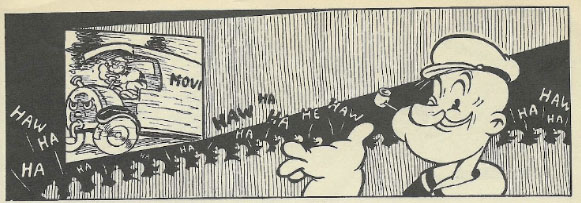
Brotherly Love:
As mentioned earlier, this is perhaps Popeye’s main theme in the 1930s. Beyond the original Popeye song, “Brotherly Love” became a staple of the cartoons in how Winston Sharples would use “Jingle Jangle Jingle” and “It’s a Hap-Hap-Happy Day” later at Famous. Not long after the studio moved to Miami, this song was phased out after 1939’s Hello- How Am I?
I want a Clean Shaven Man (From A Clean Shaven Man):
The only song with lyrics credited to Dave Fleischer himself, who may have been a writer on this cartoon. Olive uses this song to establish the kind of man she’s into, but fickle as usual, she moves in the other direction and goes out with Seegar’s character and an enemy of Wimpy, Geezil, at the end of the cartoon. A personal favorite of mine.
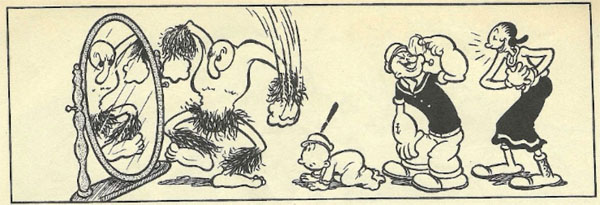
The Looney Goon:
Alice the Goon gets a few jokes made about her intelligence, that’s really all the song does. However, as mentioned earlier, it provides interest in seeing a Popeye starring the character. A 1939 Bowsky caricature draws her in with the rest of the Popeye cartoon cast (including the yet to be seen Nephews), suggesting the idea was considered. A shame it never got finished.

Let’s Build a Bridge Today (From Bridge Ahoy):
Seymour Kneitel continues his love of cartoons on construction (A Dream Walking, The House Builder Upper) with this cartoon, the only one that plays its song over the opening titles. It may have been intended to be sung by Popeye to encourage Olive and Wimpy to build the bridge, but how it plays out in the film, with a bridge well into progress, is paced far better.

Strike me Pink do I see Red:
Jealousy was a common theme in the Popeye cartoons, and to an extent I felt this was the closest Tot Seymour got a tune that could fit the Popeye Cartoons. That said, its still hard to believe, based on the art, that Olive would ever willingly hang out with Bluto in any context.
Ain’tcha got no Ettiyket:
A song that sets up Popeye’s usually un-gentleman-like behavior, it predates the conflict in Dave Tendlar’s Learn Polikeness (1938). I initially wondered if this song and Jeep, Jeep, I Give you Orchids may have been intended later on for use in the 1938 cartoons (when the Jeep first appeared in animation), especially since the aforementioned newsletter listed Polikeness as “Popeye Learns Ettiyket”. After The Spinach Roadster, leading songs became far more infrequent in Popeyes as animation moved away from their song-written, talkie origins. It’s a shame, as the songs added so much to the Popeye cartoons.
Curious to see the entire Song Folio rather than the sample and overview above? I’ve scanned my entire copy and now have it available for everyone to see at this link: Click here!
Big Thanks to Katie & Kurtis Findlay for providing a few wonderful arrangements, Devon Baxter for making keen reivisons to my writing, as well as Esther Bley, Jerry Beck, Bob Jaques & Kamden Spies for their help.